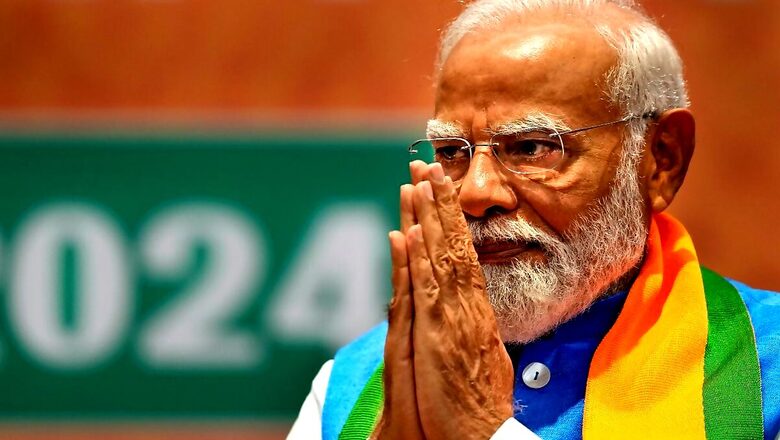
views
With just about 12 days left for the June 4 counting day, the speculation industry is on an overdrive. Myriad possibilities are being thrown up by both credible as well as self-proclaimed analysts from both sides. At the core of this speculation blitzkrieg, is the media’s need to generate watchable content and soothsayers’ desperation to keep themselves relevant till June 4.
However, with 79 per cent of the elections over and with the verdict nearly round the corner, from my close observation of the politics of the last three decades, I feel this is the right time to set the record straight on key factors that have played out during these elections.
Brand Modi is still the most relevant factor
The best example of this is Bihar and Maharashtra. In both these states, a narrative was floated by the vested ecosystem that voters are unhappy with the BJP’s choice of alliance partners and that the NDA might suffer significant losses in these two states. Contrary to all speculation, the first-hand ground feedback is very heartening.
In Maharashtra, even in the seats fought by the Shiv Sena, the enthusiasm of BJP supporters has been no less. The best example of this is the south Mumbai seat where almost all top BJP leaders campaigned for the Shiv Sena candidate. The same is believed to be reflected in the voting on these seats. In Bihar, despite an aggressive campaign by Tejaswi Yadav, there is very little traction for the RJD on the ground and the BJP is believed to be repeating its 2019 performance.
Lately, a political mercenary has been going around giving interviews to TV channels explaining why “BJP will retain its 2019 performance but this is a vote of scepticism as brand Modi has been dented.” One needs to watch these self-contradictory commentaries with a pinch of salt. Similar contrived commentaries were made before the Assembly election results last winter. Brand Modi has only grown every year and will take another huge leap on June 4.
The Silent Voter
The silent voter has always played a crucial role in Indian elections. Now who exactly is the silent voter? The silent voter is the one who often hasn’t made a pre-decided voting choice, who follows the voice of his/her conscience and whose vote is invariably for the party or alliance he/she feels will serve national interests better. This silent voter makes a decisive impact in close contests and often influences the poll outcome.
Now pre-2014, this ‘silent voter’ often used to side with the Congress as the party had succeeded in its vicious game of voter-shaming and branding the BJP voter as communal. Post-2014 and more so from 2019 onwards, this silent voter is firmly behind the BJP. It includes the ‘labhartis’ or the direct beneficiaries of government welfare schemes. The impeccable deliverance mechanism of the Modi government wherein more than Rs 36 lakh crore has been transferred directly into the bank accounts of the poor as on the current date, is a huge influencing factor for this silent voter. Similarly, based on the Modi-led NDA’s ability to fulfil key election promises in the last 10 years, the silent voter naturally finds PM Modi far more credible than Opposition leaders, most of whom are battling an acute credibility crisis.
Work Ethics
PM Modi has undertaken a marathon campaigning schedule over the last 50 days. At the age of 73 and in the intense summer heat and high humidity, his efforts have been nothing short of extraordinary. By the time the campaign ends on May 30, PM Modi will have completed 200 rallies. There have been days when he has attended 5 rallies, an impromptu roadshow, and then come back to Delhi for a lengthy one-on-one interview. He has given nearly 60 interviews in the last 5 weeks. Rahul Gandhi in comparison has only completed around 65 rallies to date and has given zero interviews.
The herculean efforts that PM Modi puts into winning elections reflect his ambitions for the nation and the party. In comparison, the lackadaisical, leisurely schedule of Rahul Gandhi and his inability to take questions shows his entitlement and under-preparedness. Someone who isn’t ambitious enough as an individual can never think and aspire big for the country. And that leaves Rahul Gandhi with his shoddy alternative of trying to divide the country on caste lines.
The difference between the work culture of the two parties is more pronounced when one compares the complete transformation of Varanasi in the last 10 years with the way Raebareli had been languishing for decades under the Gandhis. While Priyanka Gandhi keeps boasting of Congress giving AIIMs to the country, the fact is Raebareli got an AIIMS hospital only in 2018 under the Modi government. PM Modi has changed the country’s political work culture. Politics now requires a 24×7 commitment which the Gandhi siblings still seem to be struggling with.
BJP’s election machinery is inherently futuristic
The best thing about PM Modi’s work culture is the constant effort to improve the future. So while the Opposition may have woken up to the 2024 challenge only last year, for the BJP, the work on how to better 2019 had started on May 23, 2019, itself. The party knew that in terms of vote share and seats, it may have peaked in certain states. Therefore, an all-out effort was launched to cultivate new geographical ground in the south and the east. There is evidence to suggest those efforts have worked.
The BJP is likely to gain vote share and seats in at least 9 states, including Telangana, Andhra Pradesh, Tamil Nadu, Kerala, Odisha, Bengal and Punjab. This is part of a larger planning where in 2029, these would be the states that would fetch the BJP seats in very high numbers. Thus, PM Modi’s relentless efforts for the 2024 elections have actually created a fertile ground and expansion zone for the BJP for 2029.
The Opposition’s devious agenda post June 4
By circulating a doctored video of Home Minister Amit Shah and spreading falsehood on the issue of reservations, the Congress party has touched a new low in these elections. However, it seems that the Congress is likely to resort to even worse antics of denialism on June 4 and blame the Election Commission of India (ECI) for its fate. It is believed that Yogendra Yadav has been unleashed upon the media with this insidious motive – to create a false perception that the BJP is falling short – so that they could shrug off their defeat and start casting aspersions upon the election verdict.
Any honest individual who has travelled across the country would perhaps know that for all the noise that the Congress still manages to generate in the media, most of its ground workers have deserted the party. In half the states, the Congress is critically dependent upon the mercy of its regional allies who again are sceptical of giving room to the party to grow. In this hopeless situation, the Congress party is unlikely to do any better than 2019. But since self-introspection is alien to non-performing dynasts, June 4 will perhaps witness one of the biggest Opposition meltdowns in many years.
PM Modi’s ability to set and chase new agendas of national interest only makes the coming weeks more exciting!
The writer is a well-known author and national spokesperson of BJP. Views expressed in the above piece are personal and solely that of the author. They do not necessarily reflect News18’s views.




















Comments
0 comment